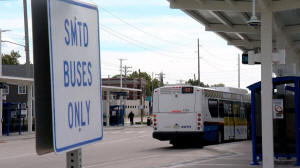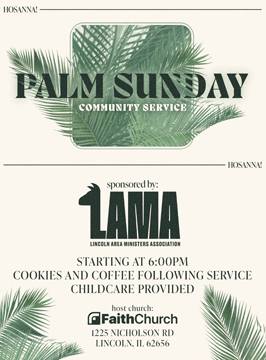It’s not just Chicago. Downstate public transit agencies face funding
challenges
[April 08, 2025]
By Ben Szalinski
SPRINGFIELD – Outside the busy systems of buses and trains moving about
a million commuters around Chicago and its suburbs every day, 54 public
transit agencies provide services throughout the rest of Illinois in
communities surrounded by farmland and or home to state colleges and
universities.
State lawmakers are spending this spring’s legislative session debating
how to solve a $771 million funding gap the Chicago area’s public
transportation agencies face in 2026. But downstate public transit
agencies are also facing a similar plight as costs rise beyond the
state’s longstanding funding commitment.
“We want (legislators) to be aware that it’s a statewide problem even
though the nature of the problem is a little different,”
Champaign-Urbana Mass Transit District CEO Karl Gnadt said in an
interview. “There is a financial problem statewide.”
The Illinois Public Transportation Association, which represents public
transit agencies throughout the state, including in Chicago, is asking
lawmakers to consider reforming the formula that doles out money to
downstate public transit agencies.
The association also projects that the Downstate Transit Improvement
Fund, which pays for infrastructure projects at downstate transit
agencies, could become insolvent by 2029 without changes to how it is
funded.

Costs exceeding state support
Chicago area transit agencies face financial challenges as federal
COVID-19 funds run out and rider patterns change thanks to
work-from-home policies adopted during the pandemic. Rider fares are
also no longer enough to cover half of the agencies’ revenue as required
by state law. That requirement was suspended during the pandemic but is
set to go back into effect this summer.
Downstate agencies are facing a different problem at the same time.
While the funding in the Chicago area, the state covers up to 65% of
expenses for downstate transit agencies. But because of rising costs and
lackluster economic growth in downstate communities that hinders sales
tax revenue, funding shortfalls are growing.
Like nearly every other sector of the economy, public transportation
agencies are facing rising costs for maintenance in addition to
recruiting and retaining employees.
A 17-year-old formula in state law requires about 7.5% of sales taxes
collected in areas served by transit agencies to be deposited into the
state’s Downstate Public Transportation Fund. The fund provides
downstate agencies with funding for up to 65% of their operating
expenses while local funding sources such as property taxes, rider
fares, bus advertisement sales and cost-sharing contracts cover the
other 35%.
More than $460 million dollars was allocated to public transportation
agencies outside Chicago through that fund in the current fiscal year.
Appropriations range from $99.6 million to the St. Clair County Transit
District that provides a portion of the rail and bus service in the St.
Louis metro area to a $209,200 for a “dial-a-ride” program for seniors
in Douglas County in East Central Illinois.
But the gap between the costs that local and state funding sources cover
is growing. In fiscal year 2024, the state deposited $150 million less
than lawmakers had budgeted, according to the association, and transit
leaders expect this gap to keep growing.
Combined with slower economic and property tax growth outside the
Chicago area, local governments are struggling to cover 35% of public
transportation costs as expenses increase.
“There’s no mechanism to get money from elsewhere,” Laura Calderon, head
of the Illinois Public Transportation Association, said. Downstate
agencies could collectively face a $42 million shortfall next year.
Though smaller than Chicago’s budget gap, just a few million dollars
less in funding could have major impacts for downstate agencies, Gnadt
said.

[to top of second column]
|

Sangamon Mass Transit District buses wait outside a bus stop in
Springfield. (Capitol News Illinois photo by Andrew Campbell)

Without funding changes, Gnadt said the Champaign-Urbana Mass Transit
District would have to implement “dramatic” service cuts.
Boosting state funding
Downstate public transportation agencies are asking lawmakers to allow
more money from sales taxes to go toward public transportation. Under a
change proposed by the IPTA, about 9.4% of sales tax revenue generated
in communities with public transportation would go toward downstate
public transit, rather than the current 7.5%.
According to the association, this change would increase funding by
$79.3 million annually beginning in fiscal year 2026. By fiscal year
2034, the association wants lawmakers to boost funding to 12%, which
would increase yearly funding by $265 million.
That’s “not much of a difference in the overall tax collection for the
state, but it’s a meaningful difference for downstate transit,” Gnadt
said.
Downstate agencies deliver a lot of services for free or reduced fares
and the typical distance traveled on trips is farther than in major
cities, meaning fare hikes are not an ideal way to raise revenue,
Calderon said.
The association is also seeking to increase the state’s portion of
funding for downstate transit agencies. Rather than having the state
cover up to 65% of operational expenses across the board, the
association wants the state to cover 75% of expenses for urban agencies
and 80% for rural agencies serving populations less than 50,000 people.
Transit officials and lawmakers are considering other proposals to
increase funding, including a new tax on electric utility companies.
Senate Transportation Committee chair Sen. Ram Villivalam, D-Chicago,
said in an interview he’s making the same request to downstate transit
agencies that he is to Chicago agencies: they must make reforms to
improve service and accountability for their riders before lawmakers
pony up money.

“Whether it’s the northeastern Illinois region of the state or
downstate, we are requesting public transit agencies to come forward
with reforms to ensure that the level of service that’s being provided
to our residents meets their needs,” Villivalam said.
That includes improving planning coordination between agencies that may
serve similar areas, Villivalam said.
While much of the legislature’s attention is on Chicago’s issues,
Calderon said lawmakers are receptive to downstate public transit needs.
“The budget is tight this year and so seeking an increase in a portion
of the state sales tax going to transit is going to be a challenge,”
Calderon said.
Villivalam observed that during nearly a dozen hearings his Senate
committee has held over the last year, there have been few objections to
increasing state funding for public transit but many calls for the state
to increase its investment.
“That has really spoken to the fact that there’s a consensus that we
need to fund public transit,” he said. “What level of service, what the
governance looks like, what level of funding — those are questions that
we’re going to come together and work on.”
Villivalam said he is “cautiously optimistic” that lawmakers will pass
transit reforms for the entire state before the General Assembly is
scheduled to adjourn on May 31.
Capitol News Illinois is
a nonprofit, nonpartisan news service that distributes state government
coverage to hundreds of news outlets statewide. It is funded primarily
by the Illinois Press Foundation and the Robert R. McCormick Foundation. |